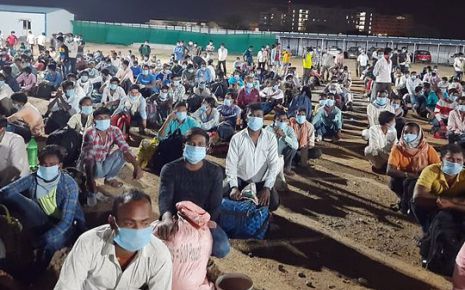Comprehensive Social Security: Benefits Under The Employees State Insurance Act, 1948
The Employee's State Insurance Act of 1948 was passed on 19th February 1948 and
came into force on 24th April 1948. It was inaugurated at Kanpur to reduce
physical ailments. It is a significant social security legislation that was
enacted in India. Its main objective is to provide health insurance to the
persons employed in the factories that consist of 10 or more than 10 persons. It
provides social security benefits to the workers and also protects them
regarding the financial distress in India.
Every human being has a right to social security hence, everyone has a right to the standard of living that is competent to the health and welfare of the person and his/her family. This act consists of 100 sections and 3 schedules. It was recommended by the Royal Labor Commission in which the 1st insurer was Pandit Jawaharlal Nehru.
It is also applied to the factories and establishments that are notified by a certain government in a particular area. It extends to the whole of India including the State of Jammu and Kashmir. For the applicability of this act, the wages/salaries of the employees must not exceed Rs.21000/-.
Contribution period - A contribution period means a 6-month time span from 1st April to 30th September and 1st October to 31st March. Thus, in a financial year, there are 2 contribution periods of 6 months duration. It is fixed to pay contributions under the ESI Act.
Benefit period - The benefit period starts 3 months after the closure of the contribution period from 1st January to 30th June of the following year and 1st July to 31st December. It is fixed to derive benefits under the ESI Act.
The health of an individual plays a vital role in one's life. The only asset that a wage earner has is their health. As a laborer secures limited earnings, ill health will cause them a complete drain which is everlasting. For every individual, health is regarded as priceless as no money will be able to compensate for its loss.
Hence, the medical benefit for a person plays an essential part in the insurance benefit. Under the ESI Act, every employee with insurance will be acquiring this benefit from the day they become an employee coming under the ESI Scheme.
This medical benefit is also extended to his family members; therefore, both the employee and the family members are entitled to the medical benefits. The retired and permanently disabled workers also acquire an annual premium of Rs. 120. Section 56 of the ESI Act states that as prescribed by the central government, the employee or his family members are entitled to medical benefits.
In case of the retirement of the employee, his spouse shall be eligible to receive medical benefits subject to payment of contribution. In case of permanent disablement by the employee, he can get medical benefits till the date of his retirement. The maximum age for retirement is 60 years.
Conditions for the medical benefit:
Sickness benefit
Under section 49 of the ESI Act, every employee with insurance is entitled to this benefit when they are unable to work due to sickness which is a cash benefit. The benefit period for the sickness is generally up to 91 days/13 weeks/3 months. The person acquires this compensation of 70% of his wage during this sickness period. However, the employee must pay his contribution for 78 days out of 6 months to utilize this benefit. If contributes for less than 78 days then he is not entitled to this sickness benefit. This benefit applies only to the employee and not to his family members.
Conditions for the sickness benefit:
In an initial waiting period of 2 days, the benefit is not issued to the employee until the sickness of the person is certified medically within 15 days of the last spell in which the sickness benefit is paid.
Maternity benefit
An insurable person, in this case, the woman can claim the maternity benefit for the following reasons:
The maternity benefit will be paid for the entire period if the insured female employee dies leaving behind the child. It will be given to the woman worker nominee if the child also dies along with the mother who is the insured woman. But if there is no nominee left then it would be given to the legal representatives of the insured woman. The same has been stated in section 50 of the ESI Act.
The dependents benefit has been created to support the family of the dead worker. The average amount of families of workers have only one breadwinner. He will be the biggest asset and the only asset to his family. The death of a breadwinner would be a disaster for the family.
According to section 52 of the ESI Act, it was stated that the benefit of the dependents is given when the employee's death has occurred. However, the death of the employee should be due to the employment injury / occupational hazard. As the name 'dependents benefit' itself contains dependents, this benefit is extended to the dependents of the dead employee as well. The dependents such as the widow, daughter, and the son. They would get about 90% of the dead employee's wage. This is given in monthly payments.
Duration of the benefit:
An insured employee is entitled to this benefit when there is a temporary/permanent injury caused to the employee due to employment injury / occupational hazard. Section 51 of the ESI Act, states the injury is based on a temporary and permanent nature. In case of temporary injury, the person is given more than 40% of their wages while in permanent injury, a particular percentage is not mentioned as it will be based on the extent of the injury and this is decided by the medical council.
Other benefits:
Other benefits are given to an insured employee in the following circumstances:
Relevant Case Laws:
Conclusion
Thus, it is vital for the Employee's State Insurance Act to work in favor of the employees and their families to support them in all kinds of aspects. This Act is advantageous to both employers and employees on the basis that employees are given sufficient benefits for any injury and on the other hand, the employers are saved from paying compensation twice to the employee for their injury which is called the double jeopardy.
End-Notes:
Every human being has a right to social security hence, everyone has a right to the standard of living that is competent to the health and welfare of the person and his/her family. This act consists of 100 sections and 3 schedules. It was recommended by the Royal Labor Commission in which the 1st insurer was Pandit Jawaharlal Nehru.
Applicability Of The Act
This act applies to the factories and establishments in which 10 or more employees are employed or were employed in a day preceding 12 months and the manufacturing process is sustained with the aid of power or 20 or more employees without the aid of power. It is not applied to the seasonal factories.It is also applied to the factories and establishments that are notified by a certain government in a particular area. It extends to the whole of India including the State of Jammu and Kashmir. For the applicability of this act, the wages/salaries of the employees must not exceed Rs.21000/-.
Contribution And Benefit Period
The main sources of finance are the contributions of employers and employees. The contribution that is paid by employees is 1.75% of their wages (after deducting PF, bonus, increments, etc.) whereas the employer's contribution is 4.75% of the wages payable to an employee. Workers are required to pay contributions every month.Contribution period - A contribution period means a 6-month time span from 1st April to 30th September and 1st October to 31st March. Thus, in a financial year, there are 2 contribution periods of 6 months duration. It is fixed to pay contributions under the ESI Act.
Benefit period - The benefit period starts 3 months after the closure of the contribution period from 1st January to 30th June of the following year and 1st July to 31st December. It is fixed to derive benefits under the ESI Act.
Benefits Under The Act
Medical benefitThe health of an individual plays a vital role in one's life. The only asset that a wage earner has is their health. As a laborer secures limited earnings, ill health will cause them a complete drain which is everlasting. For every individual, health is regarded as priceless as no money will be able to compensate for its loss.
Hence, the medical benefit for a person plays an essential part in the insurance benefit. Under the ESI Act, every employee with insurance will be acquiring this benefit from the day they become an employee coming under the ESI Scheme.
This medical benefit is also extended to his family members; therefore, both the employee and the family members are entitled to the medical benefits. The retired and permanently disabled workers also acquire an annual premium of Rs. 120. Section 56 of the ESI Act states that as prescribed by the central government, the employee or his family members are entitled to medical benefits.
In case of the retirement of the employee, his spouse shall be eligible to receive medical benefits subject to payment of contribution. In case of permanent disablement by the employee, he can get medical benefits till the date of his retirement. The maximum age for retirement is 60 years.
Conditions for the medical benefit:
- The applicant must be an insured person.
- The applicant must be in a condition where he requires medical treatment and attendance.
- To acquire the medical benefit, the applicant must have paid the period of contribution for which the medical benefit is necessary for him.
Sickness benefit
Under section 49 of the ESI Act, every employee with insurance is entitled to this benefit when they are unable to work due to sickness which is a cash benefit. The benefit period for the sickness is generally up to 91 days/13 weeks/3 months. The person acquires this compensation of 70% of his wage during this sickness period. However, the employee must pay his contribution for 78 days out of 6 months to utilize this benefit. If contributes for less than 78 days then he is not entitled to this sickness benefit. This benefit applies only to the employee and not to his family members.
Conditions for the sickness benefit:
- The applicant must be under medication in a dispensary hospital and perform the medical officer's instructions and directions.
- The applicant must not do any act that lowers the possibility of his recovery.
- Without the consent of the medical officer, the applicant is not allowed to leave the area.
- For any examination of the applicant, the duly appointed officer under the corporation must not be denied to perform.
In an initial waiting period of 2 days, the benefit is not issued to the employee until the sickness of the person is certified medically within 15 days of the last spell in which the sickness benefit is paid.
Maternity benefit
An insurable person, in this case, the woman can claim the maternity benefit for the following reasons:
- Miscarriage
- Confinement (birth after 26 weeks)
- Sickness during pregnancy/confinement /premature birth of the child/miscarriage
The maternity benefit will be paid for the entire period if the insured female employee dies leaving behind the child. It will be given to the woman worker nominee if the child also dies along with the mother who is the insured woman. But if there is no nominee left then it would be given to the legal representatives of the insured woman. The same has been stated in section 50 of the ESI Act.
- The objective of giving maternity benefits to the female workers:
- To protect the health of the mother as well as the child.
- To ease the financial hardship caused to the female worker due to the birth of her child.
- Duration of the benefit:
- Miscarriage: for 6 weeks following the date of miscarriage.
- Confinement: for not more than 6 weeks out of 12 weeks before the expected date of birth of the child.
- Sickness during pregnancy/confinement /premature birth of the child/miscarriage: for an additional period of up to 4 weeks.
The dependents benefit has been created to support the family of the dead worker. The average amount of families of workers have only one breadwinner. He will be the biggest asset and the only asset to his family. The death of a breadwinner would be a disaster for the family.
According to section 52 of the ESI Act, it was stated that the benefit of the dependents is given when the employee's death has occurred. However, the death of the employee should be due to the employment injury / occupational hazard. As the name 'dependents benefit' itself contains dependents, this benefit is extended to the dependents of the dead employee as well. The dependents such as the widow, daughter, and the son. They would get about 90% of the dead employee's wage. This is given in monthly payments.
Duration of the benefit:
- Widow: for life / till her remarriage.
- Daughter: till 18 years / her marriage whichever comes earlier. If she is an infirm then till the infirmity lasts.
- Son: till 18 years of majority. If he is an infirm then till the infirmity lasts.
An insured employee is entitled to this benefit when there is a temporary/permanent injury caused to the employee due to employment injury / occupational hazard. Section 51 of the ESI Act, states the injury is based on a temporary and permanent nature. In case of temporary injury, the person is given more than 40% of their wages while in permanent injury, a particular percentage is not mentioned as it will be based on the extent of the injury and this is decided by the medical council.
- Duration of the benefit:
- Temporary injury: the person is entitled to the benefit if the injury lasts if it does not last less than 3 days. If it is less than 3 days, then he will be awarded the sickness benefit.
- Permanent injury: the person is entitled to the benefit for the lifetime and is paid monthly.
- Liability of the employer for the injury caused to his employee in the following cases:
- Section 51B - Injury caused to the employee even when the safety instructions are followed by him.
- Section 51C - Injury caused to the employee when he is traveling in the transportation belonging to the employer.
- Section 51D - Injury caused to the employee when he tried to save or help another employer from the accident occurred at the time of employment.
- Section 51E - Injury caused to the employee while commuting from his residence to the employment or returning from the employment to his residence is considered to be done in the course of employment.
Other benefits:
Other benefits are given to an insured employee in the following circumstances:
- Funeral expenses: an amount of Rs.10,000/- is given to the person who will be performing the last rites of the dead employee.
- Old-age medical care: the person is given about Rs.120/- per annum when
retired on superannuation. It is also given to the person if he is suffering
from permanent injury and leaves the employment, this benefit is taken by
their spouses. The usual interest rate is 4.75% but if there is any delay
such as:
- Less than 2 months: 5%
- More than 4 months and less than 6 months: 15%
- More than 6 months: 25%
- Vocational rehabilitation: this is given to permanently disabled employees undergoing vocational or physical rehabilitation.
Benefits Not Assignable Or Attachable
As per Section 60 of the ESI Act, the right to receive any payment of any benefit under this Act shall not be transferable or assignable and no cash benefit payable under this Act shall be liable to attachment or sale in execution of any decree or order of any Court.Prohibition Of Combined Benefits
According to section 65 of the ESI Act, the insured employee is not entitled to multiple benefits as follows:- Both maternity and sickness benefits.
- Both temporary disablement and sickness benefits.
- Both temporary disablement and maternity benefits.
- If the person is entitled to multiple benefits, then he may choose any one of them to receive a particular benefit.
Prohibition Of Dismissal And Punishment Of Employee
As per section 73 of the ESI Act, the employer is not allowed to dismiss, punish, or discharge the employee in the following cases:- Leave due to sickness.
- Leave during the maternity period.
- Pregnancy or confinement.
- Disablement of temporary nature.
- Under hospital treatment.
Relevant Case Laws:
- Trehan v. Associated Electrical Agencies & Anr[1]
The court held that workmen covered under the ESI Act cannot claim compensation under the Workmen's Compensation Act as there is a bar under section 53 of the ESI Act
- Western India Plywood Ltd v. Sri. P. Ashokan[2]
The court held that the workman who has already claimed the benefit under the ESI Act is not entitled to claim the compensation under the Workmen Compensation Act as it will lead to double jeopardy for the employer.
Conclusion
Thus, it is vital for the Employee's State Insurance Act to work in favor of the employees and their families to support them in all kinds of aspects. This Act is advantageous to both employers and employees on the basis that employees are given sufficient benefits for any injury and on the other hand, the employers are saved from paying compensation twice to the employee for their injury which is called the double jeopardy.
End-Notes:
- (1996) 4 SCC 255.
- (1997) 7 SCC 638.
Award Winning Article Is Written By: Ms.Mandarapu Moukthica
Authentication No: AP410133881352-10-0424
Law Article in India
Legal Question & Answers
Lawyers in India - Search By City
LawArticles
How To File For Mutual Divorce In Delhi

How To File For Mutual Divorce In Delhi Mutual Consent Divorce is the Simplest Way to Obtain a D...
Increased Age For Girls Marriage

It is hoped that the Prohibition of Child Marriage (Amendment) Bill, 2021, which intends to inc...
Facade of Social Media

One may very easily get absorbed in the lives of others as one scrolls through a Facebook news ...
Section 482 CrPc - Quashing Of FIR: Guid...

The Inherent power under Section 482 in The Code Of Criminal Procedure, 1973 (37th Chapter of t...
The Uniform Civil Code (UCC) in India: A...

The Uniform Civil Code (UCC) is a concept that proposes the unification of personal laws across...
Role Of Artificial Intelligence In Legal...

Artificial intelligence (AI) is revolutionizing various sectors of the economy, and the legal i...









Please Drop Your Comments